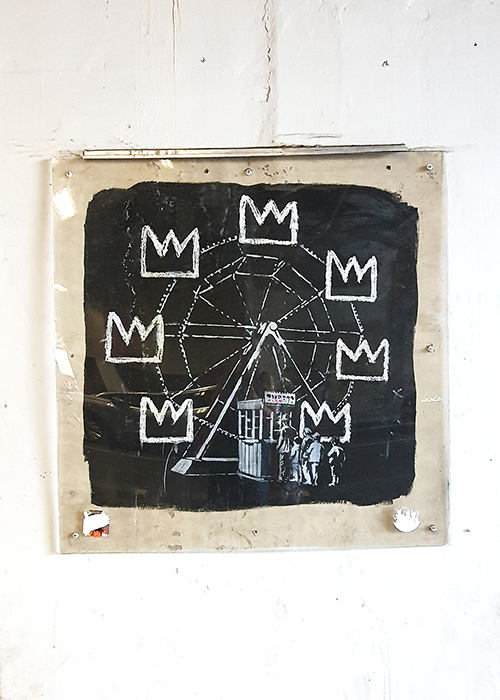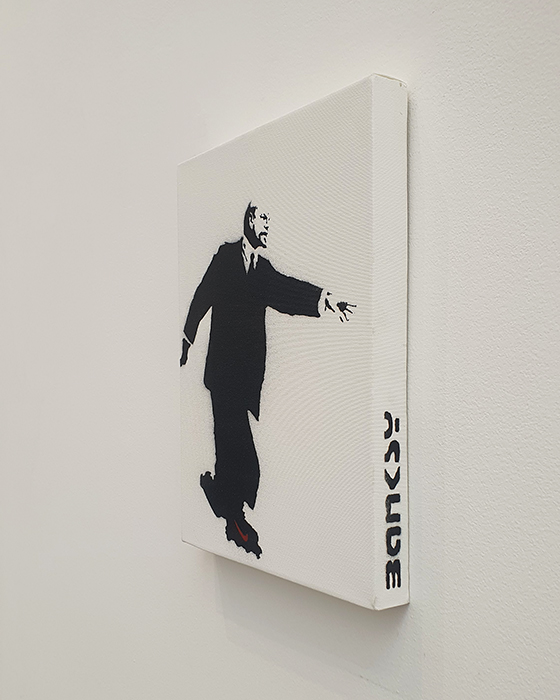Banksy, one of the most influential street artists in the world, has shaped the landscape of London’s urban art scene with his distinct and thought-provoking pieces. Whether you’re a die-hard Banksy fan or simply curious about street art, London offers an incredible variety of locations to experience his work. From his well-known street murals to pieces housed in private collections, Banksy’s art is a powerful commentary on social issues, politics, and the use of public spaces.
This guide will help you navigate London to find Banksy’s famous works—both old and new—while steering clear of unauthorized exhibitions that exploit his name for profit. As a street art enthusiast, you deserve an authentic experience, not tourist traps. So, let’s dive into this comprehensive Banksy street art guide, where you’ll discover where to find his work in London’s streets, museums, and galleries.
- Read also: “Where to Find Banksy’s Street Art in Bristol“
Why You Shouldn’t Miss Banksy’s Art in London
Banksy has left a lasting impression on London’s streets, playing a pivotal role in kickstarting the city’s street art scene. Exploring Banksy’s works in the city offers a chance to connect with one of the most impactful artists of our time. In this guide, you’ll find out exactly where to locate his art in London and learn about which Banksy exhibits are best avoided due to their unauthorized and exploitative nature.
Top Locations to Find Banksy’s Street Art in London
- Why You Shouldn't Miss Banksy's Art in London
- Top Locations to Find Banksy’s Street Art in London
- Banksy Street Art in London: Explore the Locations with This Interactive Map
- My travel and street art maps will come in useful.
- Where to See Banksy in London: Banksy's London Zoo
- Where to Find Banksy’s Art at the Barbican in London
- Where to Find Banksy’s Art at Cargo in London
- Where to Find Banksy’s Art at London's Art'Otel
- Where to Find Banksy’s Murals in London: The Graffiti Painter in Notting Hill
- Where to Find Banksy’s Murals in London: The Balcony Family in Stoke Newington
- Where to Find Banksy’s Murals in London: The Yellow Line Flower Painter in Bethnal Green
- Where to Find Banksy’s Murals in London: Banksy's Tree Mural in Finsbury Park
- Banksy’s Extinction Rebellion Mural at Marble Arch in London
- Banksy Street Art in London: Explore the Locations with This Interactive Map
- A Guide to Banksy’s Indoor Art in London: Museums, Exhibitions and Private Collections
- Banksy Street Art in London: Explore the Locations with This Interactive Map
Banksy Street Art in London: Explore the Locations with This Interactive Map
This London Street Art Map not only highlights Banksy’s famous street art locations around London but also features other murals, street art, and hidden gems I discovered during my summer-long stay. Explore local cafes, pubs, independent shops, and unique spots that showcase the city’s creative energy.
Where to See Banksy in London: Banksy’s London Zoo
During the first days of my summer-long stay in London, I found myself in the middle of something extraordinary—new Banksy pieces appearing across the city, one after another. Each day brought a fresh work, sparking excitement, curiosity, and turning the city into a playground for street art enthusiasts.
I documented this thrilling journey in two vlogs, which you can find on YouTube, and later penned a detailed article diving into Banksy’s London Zoo street art series. In that piece, I explored the deeper meanings behind the works, the buzz surrounding new Banksy unveilings, and the ongoing debate about the right to display—or remove—these public art pieces.
- Read also: “Rewilding the City Through Banksy’s London Zoo: Ownership, Removal, and the Fight for Street Art’s Freedom.”
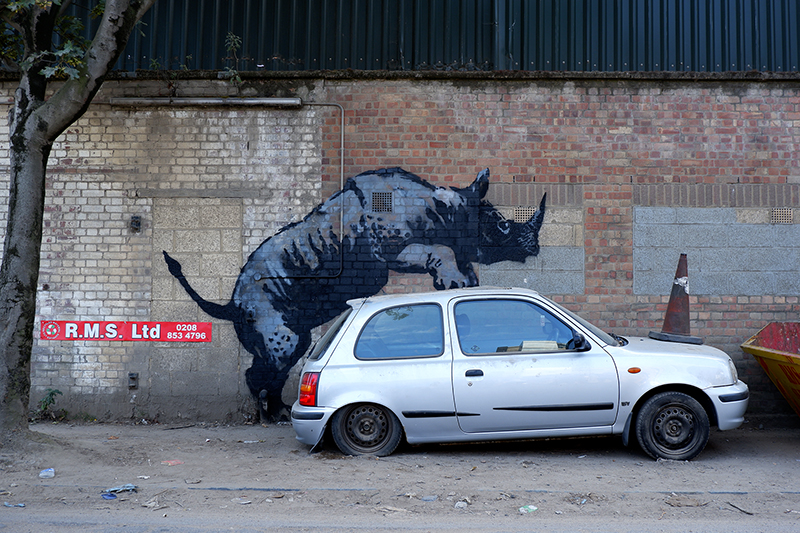
This journey also inspired an editorial in my latest newsletter, where I tackled complex themes like street art ownership, commodification, and the ethical dilemma of preserving or selling art originally intended for the public.
Since I’ve already covered Banksy’s London Zoo series in detail (you can explore these topics further through the links above), this guide will focus on the remaining London Zoo works that are still visible, along with the exact locations where you can spot them:
- Banksy’s London Zoo Gazelle: Located in Richmond, near Kew Bridge (TW9 3AW).
- Banksy’s London Zoo Elephants: Found in Chelsea, at the intersection of Edith Grove and Edith Terrace (SW10 0TQ).
- Banksy’s London Zoo Monkeys: Spotted on Brick Lane Bridge (E1 6SA), a well-known street art location.
- Banksy’s London Zoo Pelicans: In Walthamstow, at the corner of Pretoria Avenue and Northcote Road (E17 7EB).
- Banksy’s London Zoo Piranha Police Box: Currently stored inside London Guildhall, with plans to showcase it soon at the Guildhall Art Gallery.
- Banksy’s London Zoo Rhino: Located in Woolwich, on Westmoor Street (SE7 8NQ).
- Banksy’s Final London Zoo Piece: The last artwork of the London Zoo series is housed at London Zoo itself, although it is not currently on view but will be displayed in the future.
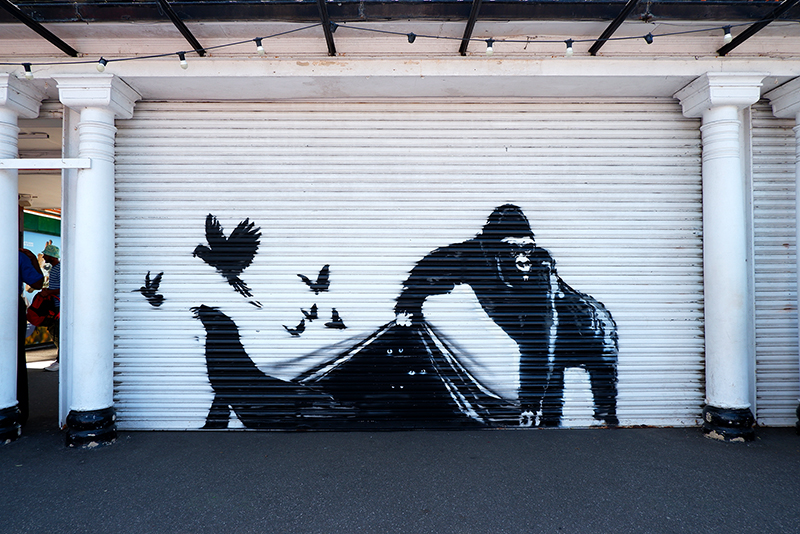
Where to Find Banksy’s Art at the Barbican in London
Banksy created two murals at the Barbican Centre in London in 2017 to mark the opening of the Basquiat exhibition, “Boom for Real.” These works are widely interpreted as a commentary on the commercialization of street art and the co-opting of countercultural movements by mainstream institutions.
- The Ferris Wheel: One mural depicts a Ferris wheel where the cars are replaced by crown-wearing figures from Basquiat’s art, referencing how Basquiat’s works, which originated as street art, are now celebrated in prestigious institutions like the Barbican. This mural plays with the irony of institutions like the Barbican promoting street art after once shunning it.
- 2. The Stop-and-Search Mural: This mural, captioned by Banksy as “Portrait of Basquiat being welcomed by the Metropolitan police – an (unofficial) collaboration with the new Basquiat show,” is a powerful commentary on racial profiling and the treatment of Black artists.
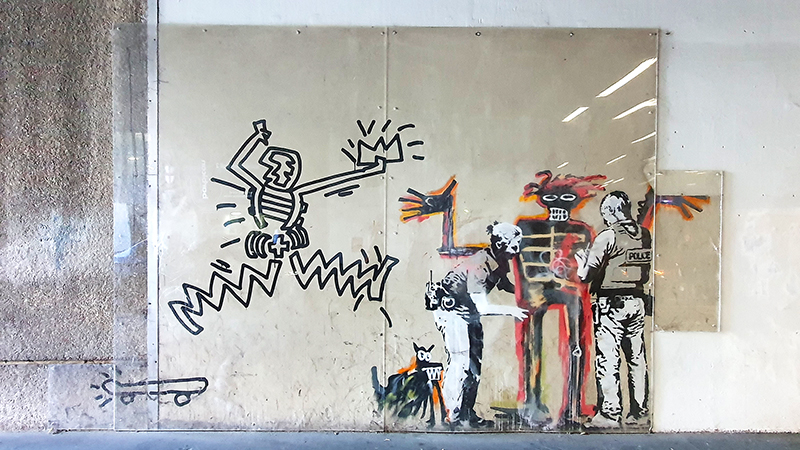
The mural is clearly inspired by Basquiat’s famous artwork Boy and Dog in a Johnnypump. In Banksy’s version, police officers are depicted frisking the boy figure while the dog looks on, symbolizing the questioning and scrutiny faced by marginalized communities.
This piece suggests how Basquiat, one of the first famous Black American artists, might be treated if he were working today, highlighting the ongoing issue of racial disparities in law enforcement. Black individuals are still disproportionately targeted for stop-and-search practices compared to their white counterparts, making Banksy’s mural a poignant critique of systemic racism.
Banksy posted these murals on his Instagram with the caption, “Major new Basquiat show opens at the Barbican – a place that is normally very keen to clean any graffiti from its walls.” These two murals are significant as they reflect both Banksy’s admiration for Basquiat and his critique of the art world’s contradictions.
Moreover, next to the Barbican, and more precisely on Chisweel Street, you can still spot a very old work by Banksy. The “I Love London, Robbo” piece is part of a long-standing feud between Banksy and the legendary graffiti artist King Robbo.
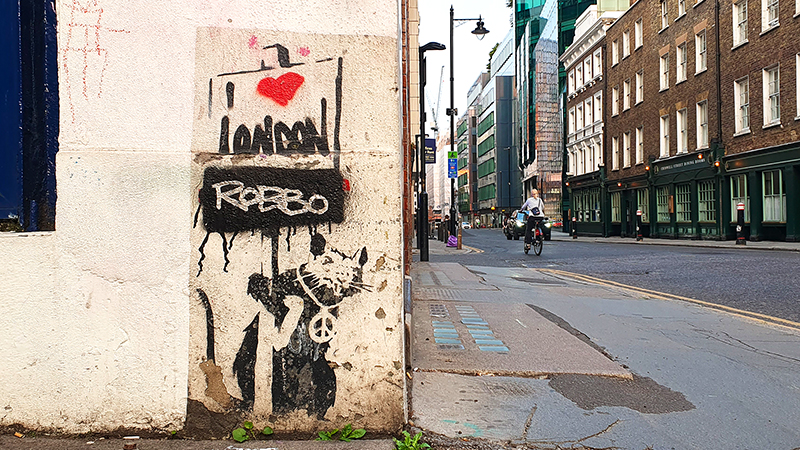
The feud began in the early 2000s when Banksy painted over one of Robbo’s iconic works on the Regent’s Canal. In response, Robbo and his supporters repeatedly altered Banksy’s works, and one of the most famous examples is the rat stencil located on Chiswell Street, near the Barbican.
Originally, the rat held a placard that read “London Doesn’t Work,” but Robbo modified it to say “I Love London, Robbo” as a bold assertion of his presence in the graffiti world. This back-and-forth tagging war between the two artists captured the attention of the street art community and became a defining moment in London’s graffiti history (there’s also an interesting documentary about it). The rivalry ended with Robbo’s passing in 2014, and since then, the altered mural has remained untouched, standing as a tribute to Robbo’s legacy. This piece is still visible today, making it a significant stop for those exploring the history of street art in London.
Where to Find Banksy’s Art at Cargo in London
Though Cargo nightclub in Shoreditch has closed and been replaced by a new restaurant, two of Banksy’s artworks still stand in its courtyard: The Guard Dog and His Master’s Voice.
- The Guard Dog (2003): This mural is a mockery of the police and authorities, depicting a policeman and his poodle patrolling a designated graffiti area. Through humor and satire, Banksy critiques the role of law enforcement in the world of street art.
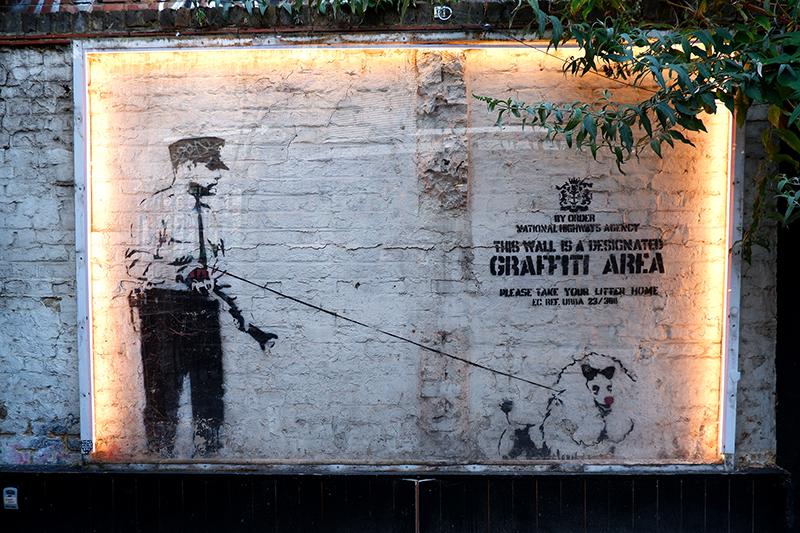
- His Master’s Voice (2003): First painted in Banksy’s hometown of Bristol, this piece was recreated in Cargo with a vibrant background of yellow and orange forms. It’s a rare collaboration with graffiti artist Stylo and features a white dog aiming a bazooka at a 19th-century gramophone. The work critiques the traditional music industry, symbolizing the conflict between conservatism and digital innovation. The gramophone, an iconic logo of a British music company, represents the old ways the dog seeks to dismantle.
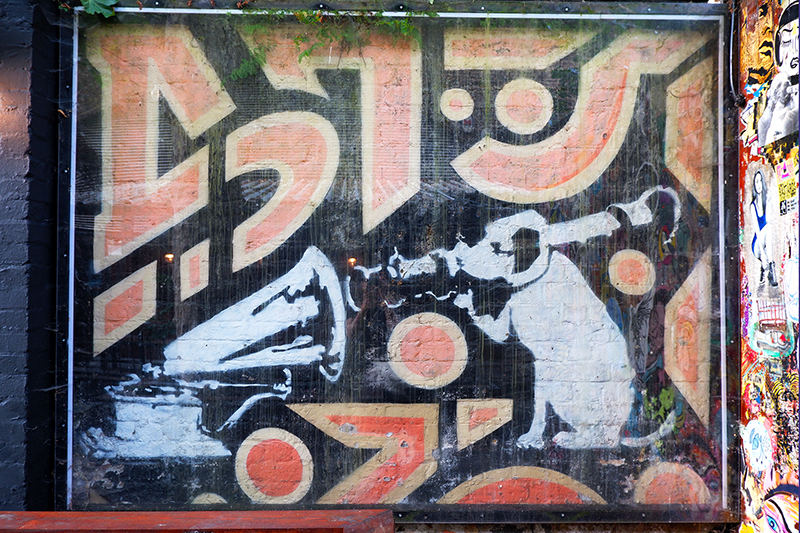
Despite Cargo’s closure, these two murals remain a must-see for street art enthusiasts exploring Banksy’s legacy in Shoreditch.
Where to Find Banksy’s Art at London’s Art’Otel
Still in Shoredtich, during the construction of the new 20-storey Art’Otel two significant Banksy pieces—originally painted on the exterior walls of The Foundry, a well-known East London pub and cultural hub—had to be carefully preserved. The Foundry was a hotspot for creatives, musicians, and artists in the early 2000s, playing a key role in Shoreditch’s street art legacy. It hosted many iconic works, including Banksy’s.
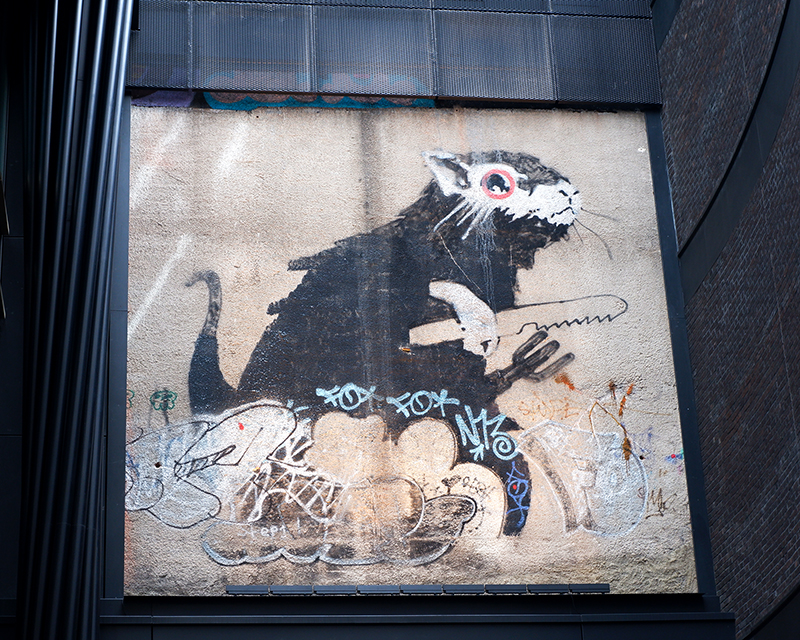
As part of the redevelopment, two of Banksy’s works—one featuring a giant rat and the other a TV being thrown out of a hotel window—were saved using a specialized demolition method. In October 2019, engineers used fabricated steel stillages to secure the walls, lifting the artworks (weighing 6 and 35 tons respectively) by crane to safely relocate them. These pieces were then incorporated into the design of the Art’Otel, preserving an important part of Shoreditch’s street art history.
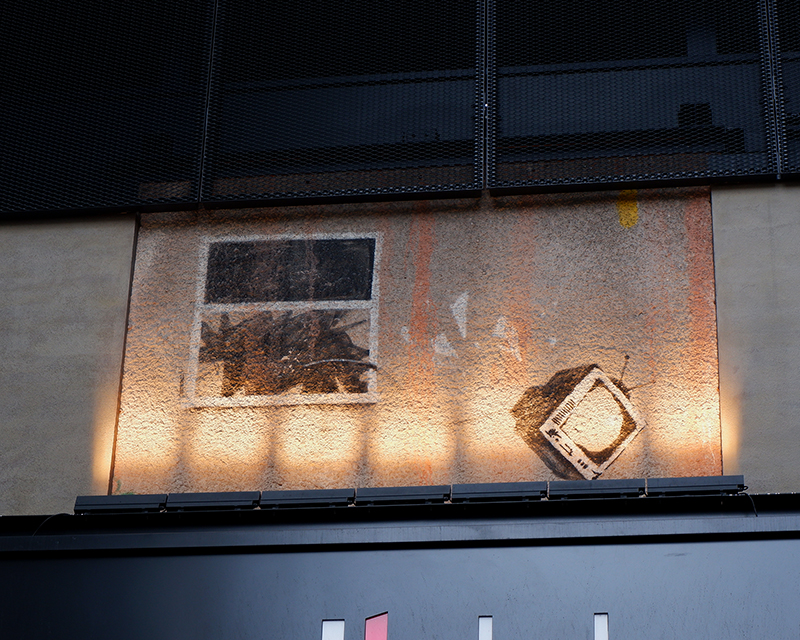
Where to Find Banksy’s Murals in London: The Graffiti Painter in Notting Hill
Banksy’s mural, The Graffiti Painter, also known as The Painter or Velázquez, was created in 2008 and can be found at the corner of Acklam Road and Portobello Road in Notting Hill. This artwork features a figure resembling the famous Spanish painter Diego Velázquez, depicted in 17th-century attire with an easel, casually painting Banksy’s name in large red graffiti-style bubble letters. The contrast between the classical painter and the modern graffiti adds a layer of irony and commentary on the fusion of traditional art forms with modern street art. Originally, the mural was covered up for several years due to nearby construction, but it was uncovered again in 2019.
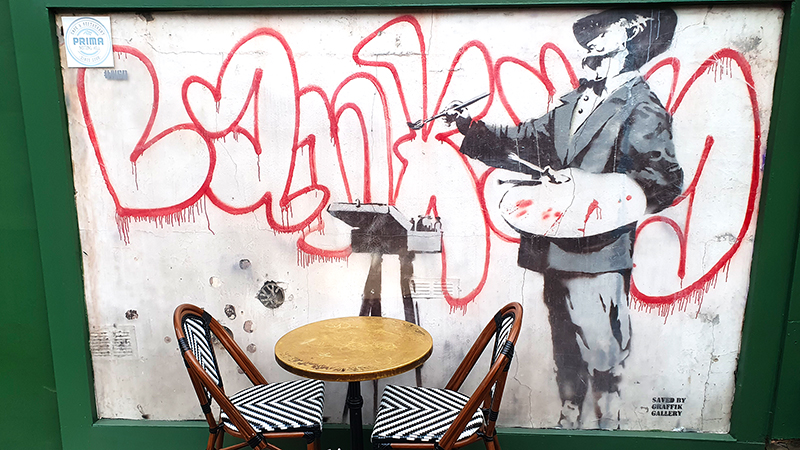
Where to Find Banksy’s Murals in London: The Balcony Family in Stoke Newington
Banksy’s The Balcony Family, also known as the Royal Family, is located on Church Street in Stoke Newington. Created in 2003, this mural humorously portrays the Royal Family waving from a balcony. The piece originally featured a full-length design, simulating the ornate trappings of a palace, painted on the side of a house. Banksy’s clever juxtaposition of grandeur and an everyday urban setting adds to the irony of the artwork.
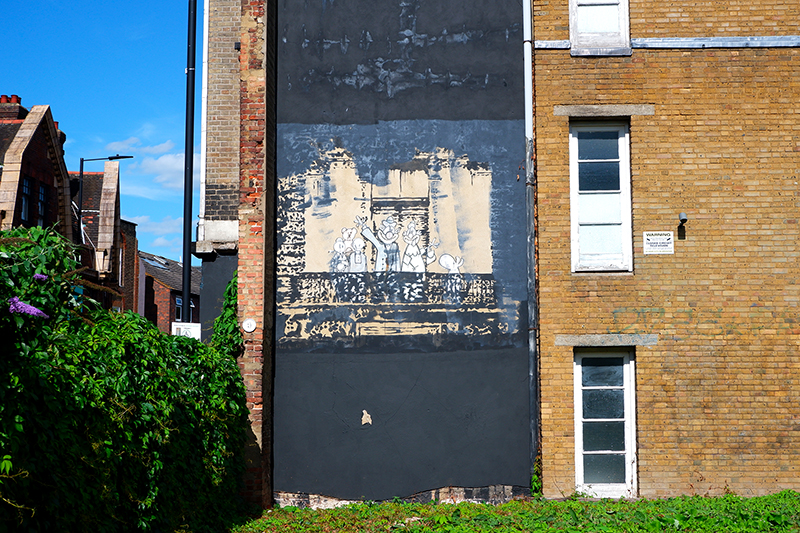
In 2009, Hackney Council attempted to buff the mural by painting over it in black, beginning with the intricate palace ornaments surrounding the family. However, locals quickly intervened, stopping the process before the entire piece was lost. Unfortunately, the black paint ruined the overall effect, leaving only the family figures stranded halfway up a blackened wall. Despite this defacement, the remaining portion of the mural has endured and continues to draw attention for its satirical take on societal hierarchies.
Where to Find Banksy’s Murals in London: The Yellow Line Flower Painter in Bethnal Green
Banksy’s Yellow Line Flower Painter, created in 2007, is located on Pollard Row in Bethnal Green. The mural originally featured a painter in overalls taking a break after painting double yellow lines on the pavement. These yellow lines extended from the street, across the pavement, and up the wall, where they transformed into a large, vibrant yellow flower. The mural humorously played on the mundane task of painting road lines, reimagining it as something unexpectedly beautiful.
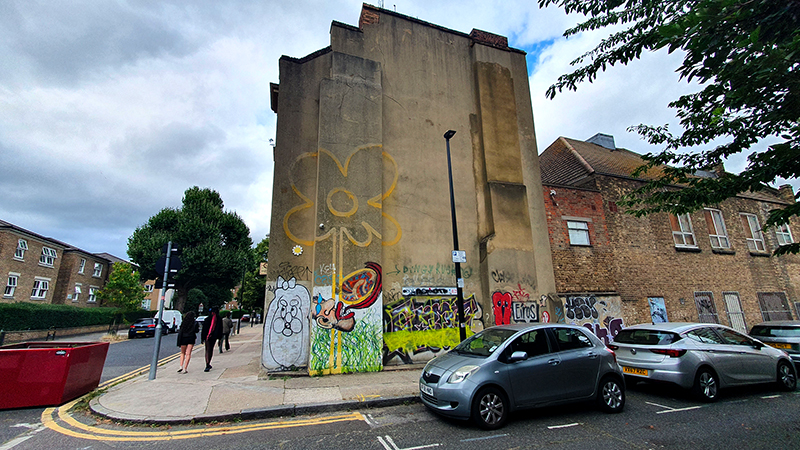
However, over the years, much of the original artwork has been lost. The painter himself has been painted over, and the double yellow lines on the pavement have been redone. Now, the only part of the mural that remains is the yellow flower, which is still visible despite damage from tagging and weathering. Despite the alterations, the flower continues to stand as a testament to Banksy’s talent for turning everyday urban elements into thought-provoking art, making this a must-see stop for street art enthusiasts in London.
Where to Find Banksy’s Murals in London: Banksy’s Tree Mural in Finsbury Park
Banksy’s Tree Mural in Finsbury Park, unveiled in March 2024, features a heavily pruned tree with bright green paint sprayed behind it, mimicking foliage, alongside a stencil of a figure holding a pressure hose. While some interpret the mural as a critique of urban nature’s “abuse” or a condemnation of greenwashing, its deeper meaning has been left open to speculation.
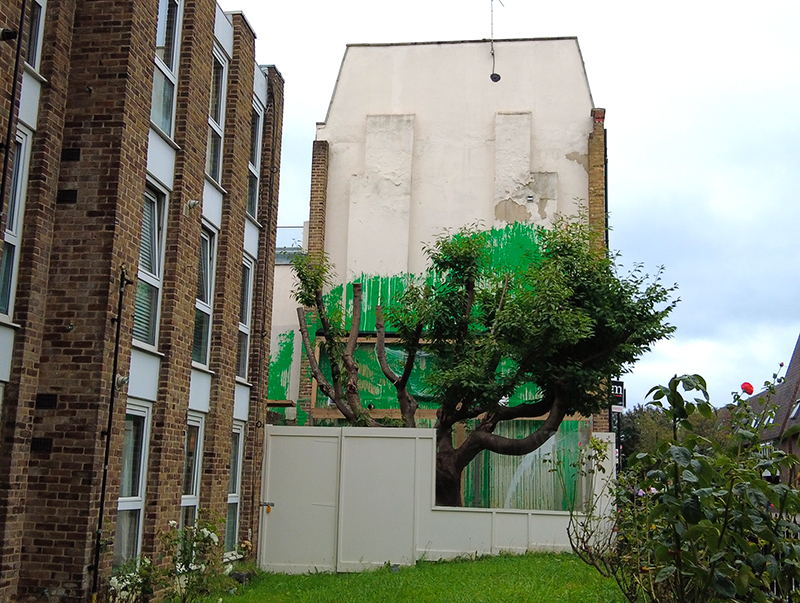
However, what they’ve done to “protect” this mural is simply ridiculous. The entire artwork, including the tree, has been fenced off, making it impossible to properly view or photograph. The tree, which is integral to the piece, can no longer be seen as it was originally intended—a stark contrast to the vibrant green splatters that represent its leaves. This effort to protect the mural seems counterproductive, obstructing not only access but also the very interaction that street art invites.
Banksy’s Extinction Rebellion Mural at Marble Arch in London
I saved this one for last because, interestingly, it has never been officially claimed by Banksy—likely due to the prominent location on the actual Marble Arch in London, where even he might hesitate to risk such a bold move. Nevertheless, it’s widely recognized as a Banksy piece, especially since this same image has previously appeared at his Walled Off Hotel in Bethlehem.
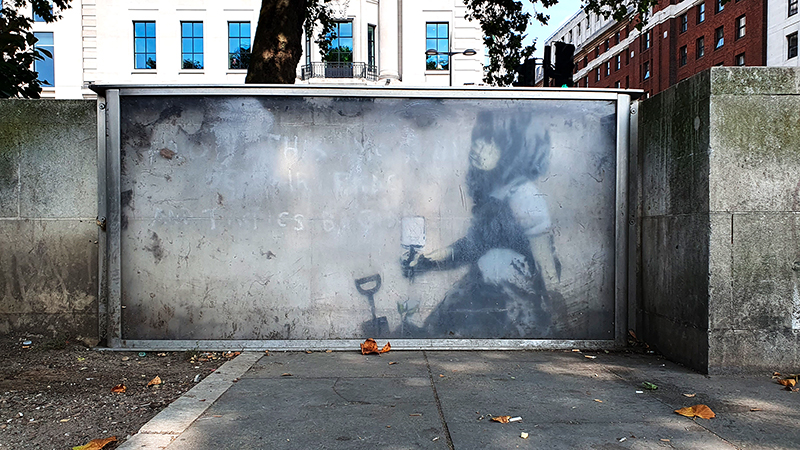
The mural appeared during the Extinction Rebellion climate protests in April 2019, as the two-week-long demonstration camp at Marble Arch was being cleared away. The artwork, which features a child planting a sapling and holding the Extinction Rebellion logo, is accompanied by the phrase: “From this moment despair ends and tactics begin.” Although it’s protected by a perspex cover (now a bit grimy), the sentence is still a powerful call for action in the face of climate change.
It’s believed that Banksy created this piece under the cover of a tent, a quiet yet defiant gesture in support of the environmental movement—one I wholeheartedly stand behind. Even though the mural’s location and the protective covering may make it harder to see clearly, its message remains undeniably resonant.
Banksy Street Art in London: Explore the Locations with This Interactive Map
This London Street Art Map not only highlights Banksy’s famous street art locations around London but also features other murals, street art, and hidden gems I discovered during my summer-long stay. Explore local cafes, pubs, independent shops, and unique spots that showcase the city’s creative energy.
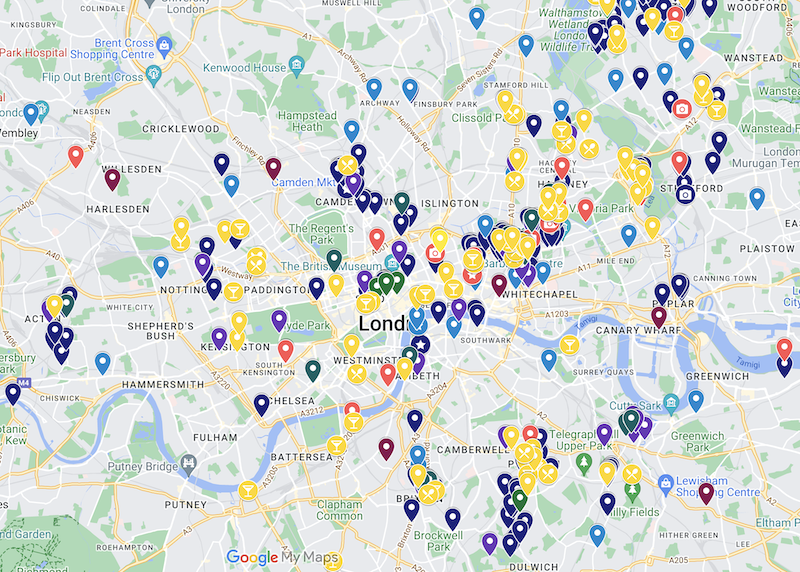
A Guide to Banksy’s Indoor Art in London: Museums, Exhibitions and Private Collections
Before bringing you to my favorite indoor collection of Banksy’s artworks in London, I want to share why you should NOT visit the exhibition “The Art of Banksy.” This unauthorized, traveling exhibition, organized by Steve Lazarides—Banksy’s former manager—features authentic works, including canvases, prints, and sculptures from private collections. However, it operates without Banksy’s permission. The artist has strongly condemned such exhibitions, which profit from his work without his involvement or consent.
Banksy has stated on his official website:
“Members of the public should be aware there has been a recent spate of Banksy exhibitions none of which are consensual. They’ve been organized entirely without the artist’s knowledge or involvement. Please treat them accordingly.”
This reflects his frustration with exhibitions like The Art of Banksy, which undermine the original intent of his art—designed to be freely accessible in public spaces, not confined to gallery walls for paying visitors.
This issue extends beyond “The Art of Banksy”—the same critique applies to the Moco Museum in London. Like The Art of Banksy, the Moco Museum is currently showcasing unauthorized Banksy works without his permission, profiting from his art while disregarding the artist’s clear stance. By visiting these exhibitions, you’re supporting the very commodification of street art that Banksy actively opposes. These shows turn art meant to challenge the establishment into a commercial product.
So, where can you visit a Banksy exhibition in London that hasn’t been publicly condemned by Banksy? Head to Newport Street Gallery in Vauxhall, where you can see his works for free, in a setting that respects the artist’s principles.
Discover Banksy’s Art in London: Newport Street Gallery’s Collection
One of my favorite collections of Banksy’s artworks can be found at the Newport Street Gallery, a free-entrance contemporary art space in Vauxhall, London, which houses part of Damien Hirst’s renowned private collection. Damien Hirst, one of the most influential contemporary artists of our time, has supported Banksy throughout his career, even providing him with studio space in his early years. The Newport Street Gallery regularly showcases works from Hirst’s collection, and during my visit, five Banksy pieces were on display as part of the temporary exhibition “Dominion.”
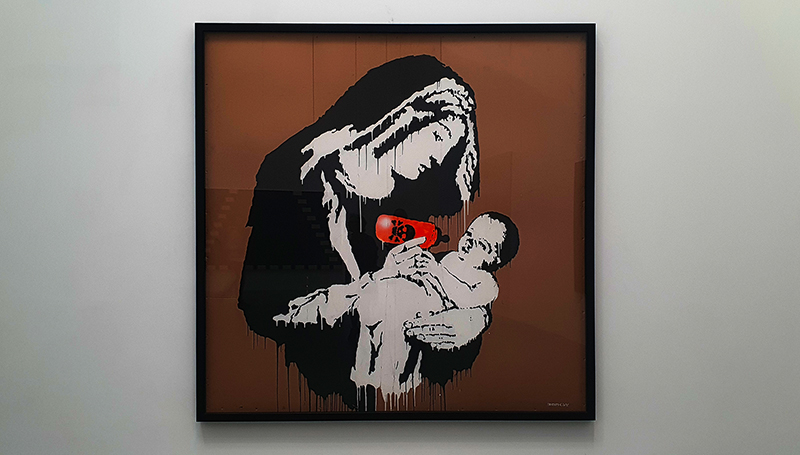
Among the standout works in Damien Hirst’s collection is Toxic Mary (2003), originally part of Banksy’s Turf War exhibition. This provocative piece reimagines the traditional Madonna and Child, with Mary feeding baby Jesus from a bottle marked with a skull and crossbones—an unsettling commentary on the toxicity of organized religion and its influence on society. Banksy challenges the comforting image of religion, suggesting that it can, at times, be more of a poison than a cure.
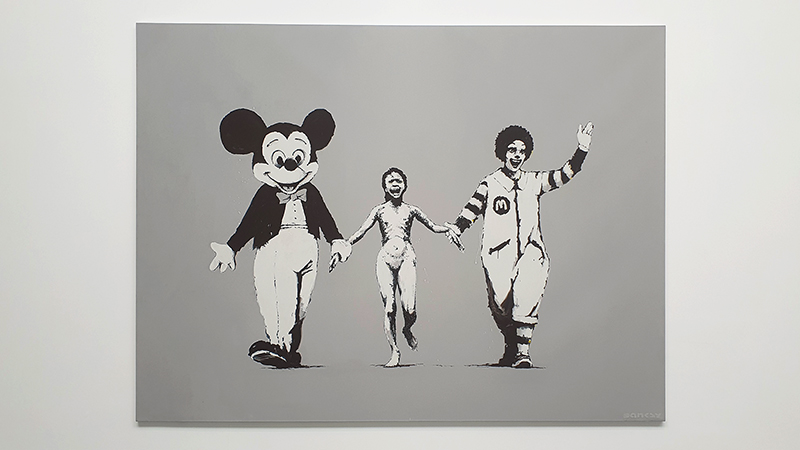
Another powerful work is Napalm (2004), a disturbing reinterpretation of the famous Vietnam War photo of a young girl fleeing a napalm attack. In this version, Banksy places the girl between Ronald McDonald and Mickey Mouse, critiquing the commodification of war and highlighting the dark side of American consumer culture. The contrast between the suffering child and these smiling icons of corporate America makes for a striking visual.
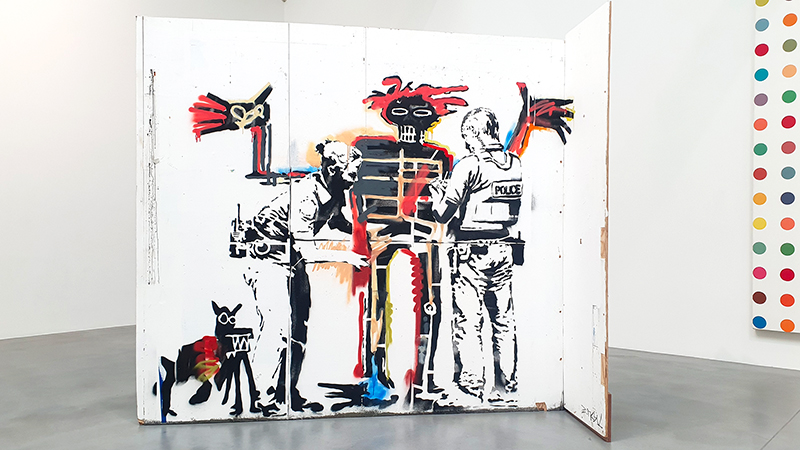
Another notable work is Lenin on Roller Skates (2003), a satirical piece that mocks the Soviet premier by depicting him rollerblading in Nike-branded skates. This humorous yet sharp critique highlights the absurdity of commercialism, as Banksy pairs a figure known for his strict political ideology with a global capitalist brand that is worlds apart from Lenin’s beliefs, thus reducing a cult-like political figure to the banalities of everyday life through a simple and ironic gesture.
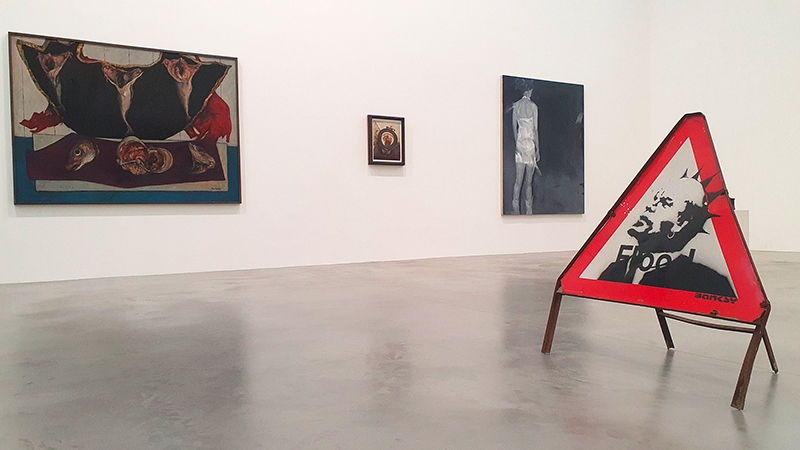
Finally, there’s “Flood Sign,” which takes inspiration from an image created by the Polish punk movement in the 1980s and first used by Banksy in Bristol in 1997, outside a public toilet. This piece features a satirical portrayal of ex-Soviet premier Lenin, transformed with a punk-style mohican haircut. By giving Lenin this rebellious makeover, Banksy mocks the authoritarian figure, blending punk subculture with political critique. The juxtaposition of the severe Soviet leader with an anti-establishment punk aesthetic challenges political power and societal norms in a playful yet thought-provoking way.
Discover Banksy’s Art in London: I Know This Pub in Hackney Wick…
One last hidden gem you might want to track down is found inside Hackney Wick’s pub, The Lord Napier Star. This piece, featuring several old-school stencils by Banksy from 2003, includes a parachuting rat—one of the artist’s signature motifs. How the pub’s owners acquired this wall art is a mystery better left unasked, but it remains a must-see for Banksy enthusiasts. The artwork also includes tributes to two of Banksy’s major influences: Keith Haring (referenced with his iconic dog) and Jean-Michel Basquiat, with the well-known quote “Life is confusing at this point.”
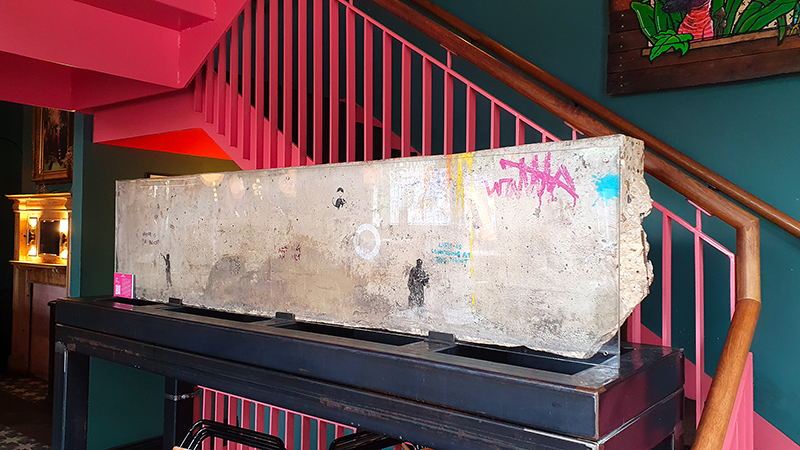
Beyond Banksy’s work, The Lord Napier Star is a treasure trove of street art, showcasing several pieces across its double façade. Artists like Phlegm, RUN, Sweet Toof, Mighty Mo, Teddy Baden, This One, Greg Abbott, and Cept have also left their mark, making this pub a hotspot for street art lovers in London.
Banksy Street Art in London: Explore the Locations with This Interactive Map
This London Street Art Map not only highlights Banksy’s famous street art locations around London but also features other murals, street art, and hidden gems I discovered during my summer-long stay. Explore local cafes, pubs, independent shops, and unique spots that showcase the city’s creative energy.

